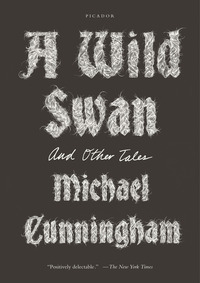Take a photo of a barcode or cover
This is a nice little volume that will fit neatly on my shelf next to Carter's Bloody Chamber and Donoghue's Kissing the Witch.
Fairy tale retellings are my thing. You knew that already.
4.5/5
4.5/5
I don't Think it's bad but it's not good too. IT was something another and really unic but IT disgust me in some way.
I enjoy reading retellings of familiar stories. This book was a nice, quick read, with some different takes on stories we know well. Side note: This pick was my "blind date with a book" from a nearby library. I love this idea.
Most fairytales have dark undercurrents, but Cunningham pulls them to the surface. Some of these stories get sinister early on, while others take a more meandering route. In the end, they all have a darker twist that I really enjoyed.
Cute re-imagining of some fairy tales with interesting illustrations. Would make a great adult gift book as the illustrations could be offensive to some parents for their wee ones.
“A Wild Swan: And Other Tales” is not a typical book by Michael Cunningham. It’s a colorful collection of fairy tales, revisited by the author, and presented to us from completely new perspectives. I was curious before starting the book if I was going to be able to recall any of the stories or characters from the fairy tales chosen by Cunningham, as the last time I remember myself reading a fairy tale was definitely more than twenty years ago. I did however find all the stories familiar and enjoyed the chance to conjure them up from the far-away corners of my memory.
If you ever had a chance to re-read any of your childhood favorite fairy tales, you’ll probably agree that a lot of times they seem illogical and cruel, and that their characters do things whose motivation is utterly unclear, although these are never questioned by a child. Cunningham questions the irrationality of the fairy tales and masterly invents the motivation and background behind all these actions and events we used to take for granted. Have you ever asked yourself why could a gnome want a queen’s firstborn child? And how did the life of the guy who retained a swan’s wing instead of his arm looked like? Cunningham places the characters and the events of the fairy tales in the modern times. If magic can happen at all, why does it have to be in the past? Why do we always see fairy tales as something that has happened really long ago?
Another aspect of these revisited fairy tales I really loved was the author’s ability to tell them from totally unexpected perspectives. He gives voices to both good and evil characters, main and secondary or unnoticed ones.
A witty and entertaining read.
Note: I obtained this book through NetGalley.
If you ever had a chance to re-read any of your childhood favorite fairy tales, you’ll probably agree that a lot of times they seem illogical and cruel, and that their characters do things whose motivation is utterly unclear, although these are never questioned by a child. Cunningham questions the irrationality of the fairy tales and masterly invents the motivation and background behind all these actions and events we used to take for granted. Have you ever asked yourself why could a gnome want a queen’s firstborn child? And how did the life of the guy who retained a swan’s wing instead of his arm looked like? Cunningham places the characters and the events of the fairy tales in the modern times. If magic can happen at all, why does it have to be in the past? Why do we always see fairy tales as something that has happened really long ago?
Another aspect of these revisited fairy tales I really loved was the author’s ability to tell them from totally unexpected perspectives. He gives voices to both good and evil characters, main and secondary or unnoticed ones.
A witty and entertaining read.
Note: I obtained this book through NetGalley.
NL: 3,5/5 - A Wild Swan is een verzameling van sprookjeshervertellingen van bekende (Belle en het Beest, Sneeuwwitje, Repelsteeltje) en minder bekende sprookjes. Cunningham herschrijft deze in een heel eigen schrijfstijl, die perfect past bij de donkere sfeer die deze vertellingen oproepen. De personages in deze sprookjes zijn optimistisch en gemeen en de sprookjes eindigen zelden zoals je verwacht had.
Een leuke collectie voor wie zin heeft in donkere sprookjes, die doen denken aan de oorspronkelijk verhalen van de gebroeders Grimm.
EN: 3,5/5 - A Wild Swan is a collection of dark fairy tale retellings of known (Beauty and the Beast, Snowwhite, Rumpelstiltskin,..) and lesser known stories. Cunningham writes these in a very distinctive style, which works perfectly for creating dark and ominous settings. The cruelty and optimism in these stories made me think of the Grimm brother stories I read as a child, which I rather appreciated.
Een leuke collectie voor wie zin heeft in donkere sprookjes, die doen denken aan de oorspronkelijk verhalen van de gebroeders Grimm.
EN: 3,5/5 - A Wild Swan is a collection of dark fairy tale retellings of known (Beauty and the Beast, Snowwhite, Rumpelstiltskin,..) and lesser known stories. Cunningham writes these in a very distinctive style, which works perfectly for creating dark and ominous settings. The cruelty and optimism in these stories made me think of the Grimm brother stories I read as a child, which I rather appreciated.
This is a lovely collection of alternative fairy tales, with quirky endings. Many other authors have gone this route, with varying results, so it is quite a risk for someone as established as Cunningham, he of “The Hours”’ fame to try it out. Thankfully the collection succeeds. Add to that, the captivating illustrations by New York-based Japanese artist Yuko Shimizu and the result is stunning.
In the title story, the sister’s act of devotion to her twelve brothers, to free them from the curse of their wicked witch of a stepmother falls just short of the perfection of the original tale, with devastating consequences on the twelfth brother, that sees him plying seedy bars in the outskirts of the city, as a semi-freak.
“Beast” touches on the hidden evil that resides in most of us, even the doting father of Beauty, that taints the acts of love in the original, which makes it even more insidiously awful. Rumpelstiltkin appears as the focalizer in “Little Man”, as the witch in Hansel and Gretel in “Crazy Old Lady”, and they turn out to be a lot more human and empathetic than the requisite heroes and heroines. And if you ever wondered how Snow White sustains her passion with her prince after happy after, look no further, because “Poisoned” updates the curious reader on just that. Jack of the Beanstalk fame is honestly called a gullible layabout who sells the last family cow for a handful of magic beans in “Jacked”.
Perhaps the only flaw to this otherwise enjoyable collection is the random elements thrown in, like references to the subway, the transformation of Hansel and Gretel into pierced and tattooed teens, and other references to connote modernity, which sometimes jar rather than serve a literary purpose.
In the title story, the sister’s act of devotion to her twelve brothers, to free them from the curse of their wicked witch of a stepmother falls just short of the perfection of the original tale, with devastating consequences on the twelfth brother, that sees him plying seedy bars in the outskirts of the city, as a semi-freak.
“Beast” touches on the hidden evil that resides in most of us, even the doting father of Beauty, that taints the acts of love in the original, which makes it even more insidiously awful. Rumpelstiltkin appears as the focalizer in “Little Man”, as the witch in Hansel and Gretel in “Crazy Old Lady”, and they turn out to be a lot more human and empathetic than the requisite heroes and heroines. And if you ever wondered how Snow White sustains her passion with her prince after happy after, look no further, because “Poisoned” updates the curious reader on just that. Jack of the Beanstalk fame is honestly called a gullible layabout who sells the last family cow for a handful of magic beans in “Jacked”.
Perhaps the only flaw to this otherwise enjoyable collection is the random elements thrown in, like references to the subway, the transformation of Hansel and Gretel into pierced and tattooed teens, and other references to connote modernity, which sometimes jar rather than serve a literary purpose.




